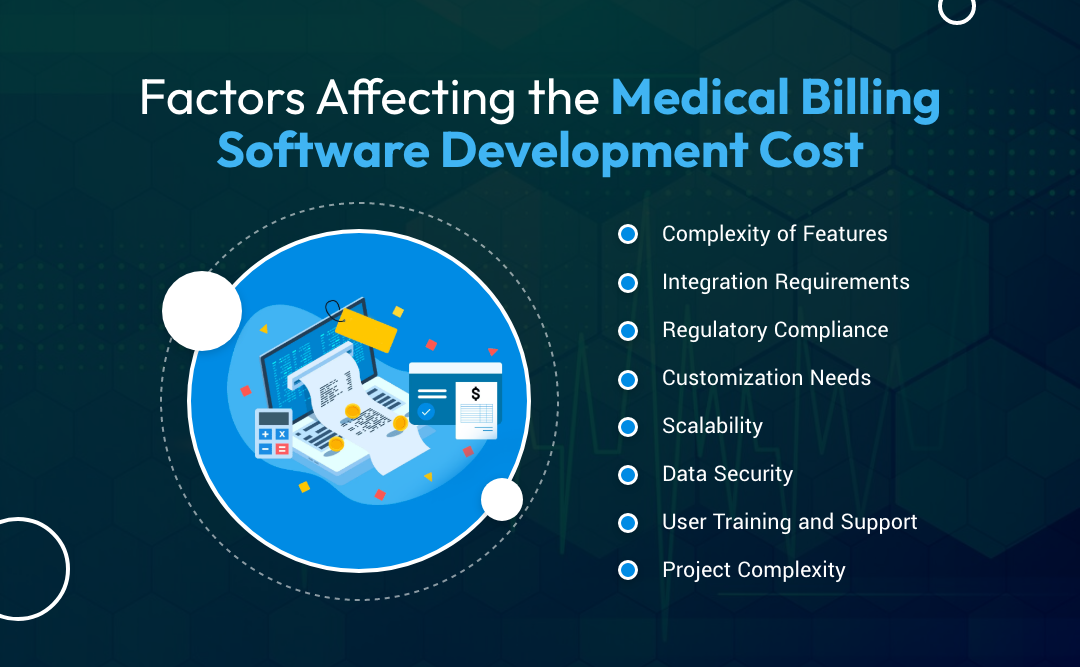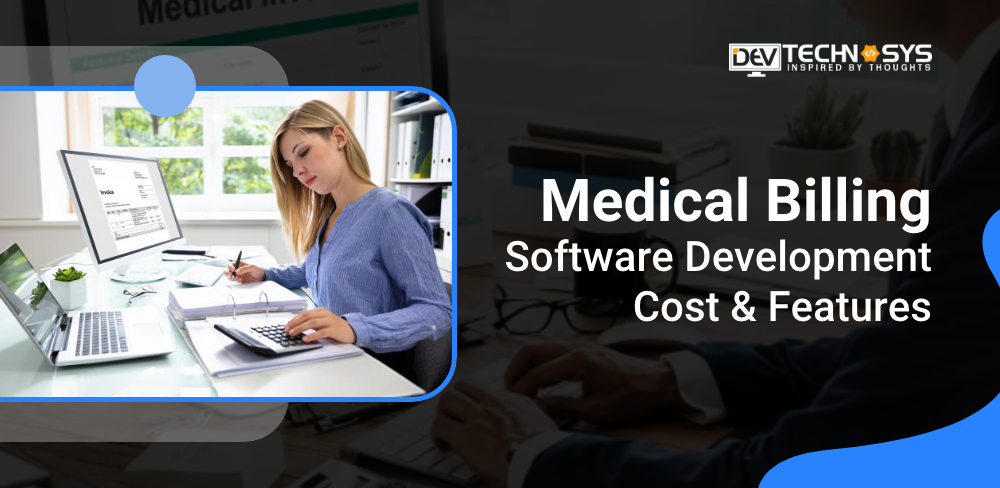“Medical billing is the bridge that connects healthcare and finance, ensuring the healing and the billing align.”
By 2028, the global healthcare industry will be valued at $665.37 Billion. In the United States, healthcare expenditure is expected to reach a staggering $6.25 trillion within the same timeframe. These data highlight the urgent need for cost-effective, effective medical billing, regardless of the size or specialization of your healthcare facility. However, the medical billing software development cost should be a major consideration for healthcare providers who want to streamline their financial operations.
This blog will help to demystify some of the factors that influence the cost of developing medical billing software. We’ll explore the different factors that influence the overall cost, from initial planning to the software deployment.
Whether you run a small hospital or clinic, knowing these medical billing software development costs will allow you to make an informed choice. Find out what goes into financial planning for a custom billing solution.
So let’s begin.
What is Medical Billing Software?
Medical billing systems process payment paperwork and code, which allows financial processes to run faster and reduces time-consuming manual activities. Billing is an important part of healthcare, and a system that can manage claims, maintain billing codes, and provide data could improve the efficiency of medical practices.
The medical accounting software, enhanced with chatbots in the healthcare industry, must efficiently record and verify each invoice, categorize payment data, ensure timely transactions, and eliminate duplicate claims. Its integration aids in seamless claims processing throughout the revenue cycle, streamlining administrative tasks and improving overall operational efficiency.
Market Overview of Medical Billing Software
- The US medical billing outsourcing market was valued at USD 5.4 Billion in 2022, and is expected to reach USD 15.68 Billion by 2032. This represents a CAGR between 2023-2032 of 11.3%.
- In the United States, 30% of persons between the ages of 35 and 44 indicated in June 2022 that they had received an unexpected medical bill following medical care.
- The expected value of the worldwide digital health market in 2019 was $175 billion. In 2025, the digital health industry is projected to reach about 660 billion dollars, with a compound annual growth rate (CAGR) of nearly 25 percent from 2019 to 2025.

- The global market for EHRs is expected to grow to a size of over 47 billion dollars by 2027.
- Medical debt is incurred by 50% of US citizens, up 4% from 2020.
- In the most recent calendar year, 48% of US families incurred healthcare costs, with 17% incurring costs over $1,500.
Features of Medical Billing Software Development
Developing medical billing software involves a range of essential features to streamline the billing and reimbursement process for healthcare providers. As per software development company, below are some of the essential features that can affect the medical billing software development cost. So let’s check out the features:

1. Patient Registration and Management:
Patient Registration and Management is a cornerstone of any custom medical billing software. The management of patient information is a must for billing accuracy. The medical billing software development cost will increase, but this feature is a vital investment.
2. EHR/EMR Integration:
The next item on the list is Electronic Health Records Integration (EHR). This feature allows seamless communication of clinical and financial data. This feature is essential to avoid disorganized workflows, which can lead to billing errors. EHR Integration is a medical billing software benefit that offers unprecedented operational cohesion.
This makes it easier to manage healthcare and billing metrics. When you integrate this feature into your software, the EMR/EHR software development cost increases.
3. Claim Management:
Claim Management is another must-have feature. This tool automates claim creation, submission, and tracking, reducing the need for manual labor as well as the risk of error. This feature may increase the cost of developing medical billing software, but it will save time and reduce errors in the long run.
4. Coding and Auditing:
Coding and Auditing is a feature of medical billing software that helps ensure that medical procedures are correctly coded. Correct coding is essential for accurate billing and compliance to legal regulations. The medical billing software development cost will increase, but the benefits in terms of reduced risks of non-compliance are worth it.
5. Payment Gateways:
Secure Payment Gateways are a vital feature. You should hire software developers who can integrate a payment gateway that is reliable, can enhance the customer’s experience, and add to the benefits of medical billing software cost. It’s important to note that the cost of developing medical billing software will be affected by adding HIPAA-compliant and secure payment gateways.
6. Reporting and Analytics:
The importance of Analytics and Reporting is crucial to assessing the financial status of healthcare institutions. These features allow the organization to track revenues, identify billing errors, as well as analyze different performance metrics.
The medical billing software development cost of these features is high, but the benefits such as revenue optimization and data-driven decisions are well worth it.
7. User-friendly Dashboard:
A user-friendly dashboard is not just a matter of aesthetics. This is the heart of your medical billing software. Workflow efficiency can be affected by the ease of navigation through different functions. In order to develop medical billing software that has an intuitive dashboard, extra design and user-experience testing are usually needed, which affects the overall budget.
8. Multi-user Access Control:
In many healthcare organizations, multiple employees access the clinic billing software to perform different tasks. Multi-user access control is therefore essential to maintain data integrity and roles-based access.
This ensures that sensitive data can only be changed by authorized personnel. It can be difficult to implement, but it is an important feature when developing medical billing software.
9. Automated Reminders & Notifications:
Automated reminders and notifications are a must. These alerts are set up for a variety of tasks, including reminding staff members about pending invoices or informing them about the status of claims. These features will add convenience and efficiency to your medical billing software.
10. Measures of Compliance and Security:
Compliance and Security Measures, last but not least, are vital for protecting the sensitive data of patients and avoiding legal consequences. It is not optional to implement high-level security measures and comply with regulations such as HIPAA, GDPR, or other regulatory requirements. These features are important in determining medical billing software development cost.
Read More: Mental Health EHR Software Development
How Much Does Medical Billing Software Development Cost?
Medical billing software development cost can vary widely depending on a number of factors. These include the complexity, features, and technology stack as well as the location of the software product development team. It is difficult to provide an exact cost to build medical billing software without a thorough project analysis.
Here is a rough estimate based on estimates and market analyses:
1. Basic Medical Billing Software:
This simple software has essential features such as patient information management, billing, and claims generation. It could cost between $10,000 and $15,000.
2. Middle-range Medical Billing Software:
The cloud medical billing software with features such as insurance eligibility verification, denial handling, enhanced reporting capabilities, and integration with EHR/EMR Systems could cost between $15,000 and $20,000.
3. Advanced Medical Billing Software:
A web-based medical billing software that includes advanced features like predictive analytics, machine-learning capabilities, custom integrations, and security measures, could cost up to $25,000 or more.
These are only rough estimates based on different surveys. It is best to consult a healthcare software development company for a more detailed discussion of your requirements and a Medical billing software development cost estimate based on the unique needs of your project.
Factors Affecting the Medical Billing Software Development Cost
When determining the Medical billing software development cost, several factors come into play. In this section, we’ll explain the factors that influence the cost of software development.

1. Complexity of Features:
The complexity of features can have a significant impact on costs. Complex functionalities such as real-time eligibility checks, IT solutions for patient engagement, and detailed reports require extensive coding and testing. They also require more development hours. These complications can increase medical billing software development costs.
2. Integration Requirements:
When you integrate the best medical practice management software like Electronic Medical Records or Practice Management software can be a double-edged sword. It is important to have seamless data exchange, but it can be costly.
3. Regulatory Compliance:
It is a non-negotiable to ensure that the medical billing software adheres to healthcare regulations and in particular HIPAA. Compliance requires expertise, meticulous documentation, and rigorous testing. These factors all contribute to the cost of development.
4. Customization Needs:
The level of customization needed to align software with unique workflows and requirements can have a major impact on medical billing software development cost. Customizing the medical device software development to precisely fit within an organization’s operating framework increases complexity and development time.
5. Scalability:
Although developing a solution that is scalable requires an initial investment, the cost savings over time can be significant. Software that is scalable can adapt to changing demands without extensive redevelopment. Scalability may be built into the design, but this can increase costs.
6. Data Security:
Healthcare software development services must ensure robust data security, including encryption, access control, and compliance with standards. These measures are not only important for protecting patient data but also contribute to medical billing software development cost.
7. User Training and Support:
Budgeting for ongoing user support and training is crucial. To ensure that staff are able to use the software effectively, it is necessary to invest in training sessions, materials, and support resources. These should be included as part of the total cost.
8. Project Complexity:
Costs can be affected by the complexity of a project. The number of participants, the geographic location of the organization, and the level of coordination needed can all affect the timeline for development and costs.
How to Reduce the Cost of Medical Billing Software Development?
You may find it difficult to manage the financial aspect of software development. However, with clear guidelines and strategic planning, you can reduce costs when building your custom medical billing system. Here are some tips on how to control your expenses.

1. Clear Project Requirements:
It is important to be clear about your needs when building medical billing software. If, for example, a dental office initially wants only billing capabilities, but decides later to integrate a scheduling system with it, the costs will increase. Set clear and detailed requirements at the beginning to avoid this.
2. Cost-effective Strategies:
Agile methodologies allow for incremental development and help manage medical billing software development costs. Each sprint allows you to evaluate costs and features, allowing you to make adjustments as necessary. This is especially beneficial when creating medical billing software.
3. Prioritize Features:
To optimize healthcare CRM software development costs, prioritize essential features initially. Subsequent phases can incorporate user feedback and evolving needs, ensuring a cost-effective and user-centric solution.
4. Outsourcing:
Hire saas development services teams in regions with lower labor costs. It can be a great way to reduce costs. However, you should consider the trade-offs that may occur due to time zones or language barriers.
5. Open Source Tools:
Open-source hospital accounting software can reduce costs. However, it is important to ensure that the components are compatible and compliant to avoid costly adjustments in the future. These strategies will help you to control costs better and make informed decisions during the entire development process.
Conclusion
Developing custom medical billing software can have a major impact on the efficiency and accuracy of healthcare billing. Costs will depend on the specific needs of your organization, level of customization, and regulatory compliance.
Therefore, when seeking to develop such software, consider hiring an experienced custom software development company that specializes in healthcare solutions to ensure a robust, compliant, and cost-effective system tailored to your needs.
Frequently Asked Question
1. How to Develop Medical Billing Software?
To develop medical billing software for your healthcare business, you must follow the below steps:
- Gather requirements from healthcare professionals.
- Choose a development platform and technology stack.
- Design a user-friendly interface.
- Implement features for patient data, coding, claims, and payment processing.
- Ensure compliance with healthcare regulations.
- Test rigorously for accuracy and security.
- Launch the software and provide ongoing support and updates.
2. How Does Medical Billing Software Work?
Medical billing software streamlines the billing process in healthcare. It captures patient data, codes procedures, and creates insurance claims. These claims are then submitted electronically, and the software tracks their status, helping providers manage revenue cycles, reduce errors, and improve reimbursement efficiency.
3. What Are the Benefits of Medical Billing Software Development?
Medical billing software development streamlines billing processes reduces errors, improves efficiency, enhances accuracy, and ensures compliance, ultimately saving time and money for healthcare providers. Recent research estimated that the global market for medical billing will be worth an enormous $14.2 billion by 2023.
4. What is the Cost of Developing AI-powered Medical Billing Software?
The cost of developing AI-powered medical billing software can vary significantly, depending on features, complexity, and development resources, but it often ranges from $15,000-$30,000.






























